Story by 16-year-old Grant High School student Adah Crandall.
Last fall I had the opportunity to participate in PBOT’s Traffic and Transportation Class. I was at least a decade younger than everyone else there, but as a youth climate organizer, it was a dynamic I’m all too familiar with.
As a final project for the class, each student presented a proposal to solve a transportation issue in our community. The ideas ranged from cleaning up leaves in bike lanes to creating safer intersections, to improving local walkability.
My proposal was to create a series of workshops or a school curriculum to help incoming high school students get oriented with Portland’s transit system, and teach them how to better utilize the resource of free transit passes provided by Portland Public Schools.
When I surveyed my peers last fall, a striking number of them said that they either didn’t know how to or didn’t feel safe using the bus or MAX. The safety piece was disproportionately true for female, transgender, and BIPOC students.
“It is crucial we educate the next generation so they understand cars are not — and should not be — the only mobility option. We have driver’s ed, but we don’t have transit rider’s ed?”
In order to build an equitable, multimodal transportation system, it is crucial we educate the next generation so they understand cars are not — and should not be — the only mobility option. We have driver’s ed, but we don’t have transit rider’s ed?
As a high school student, I’ve spent the last few months watching many of my classmates get their driver’s licenses. That little plastic card is a coveted ticket to independence, one that students crave and the media glorifies.
As a climate and transportation justice activist, I’m faced with a moral dilemma: getting my license feels like giving into the status quo; but I am also acutely aware of the fact that the climate crisis is not the fault of individuals like me, but of systemic failures to reduce emissions at a global scale. (And I’d be lying if I said I didn’t envy my classmates’ ability to easily go on day trips to the woods or the coast, or get to school without it taking 40 minutes and two different buses!)
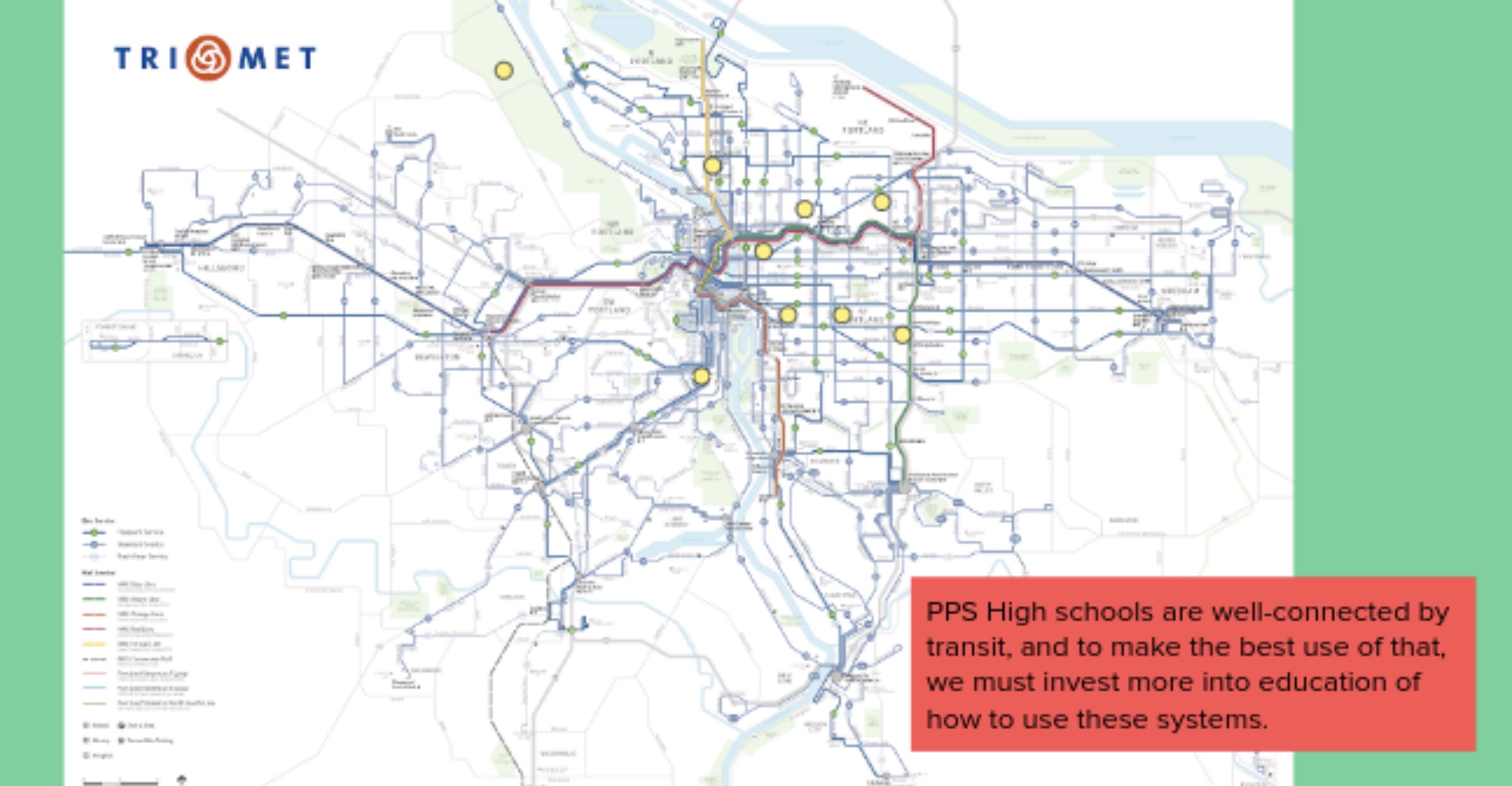

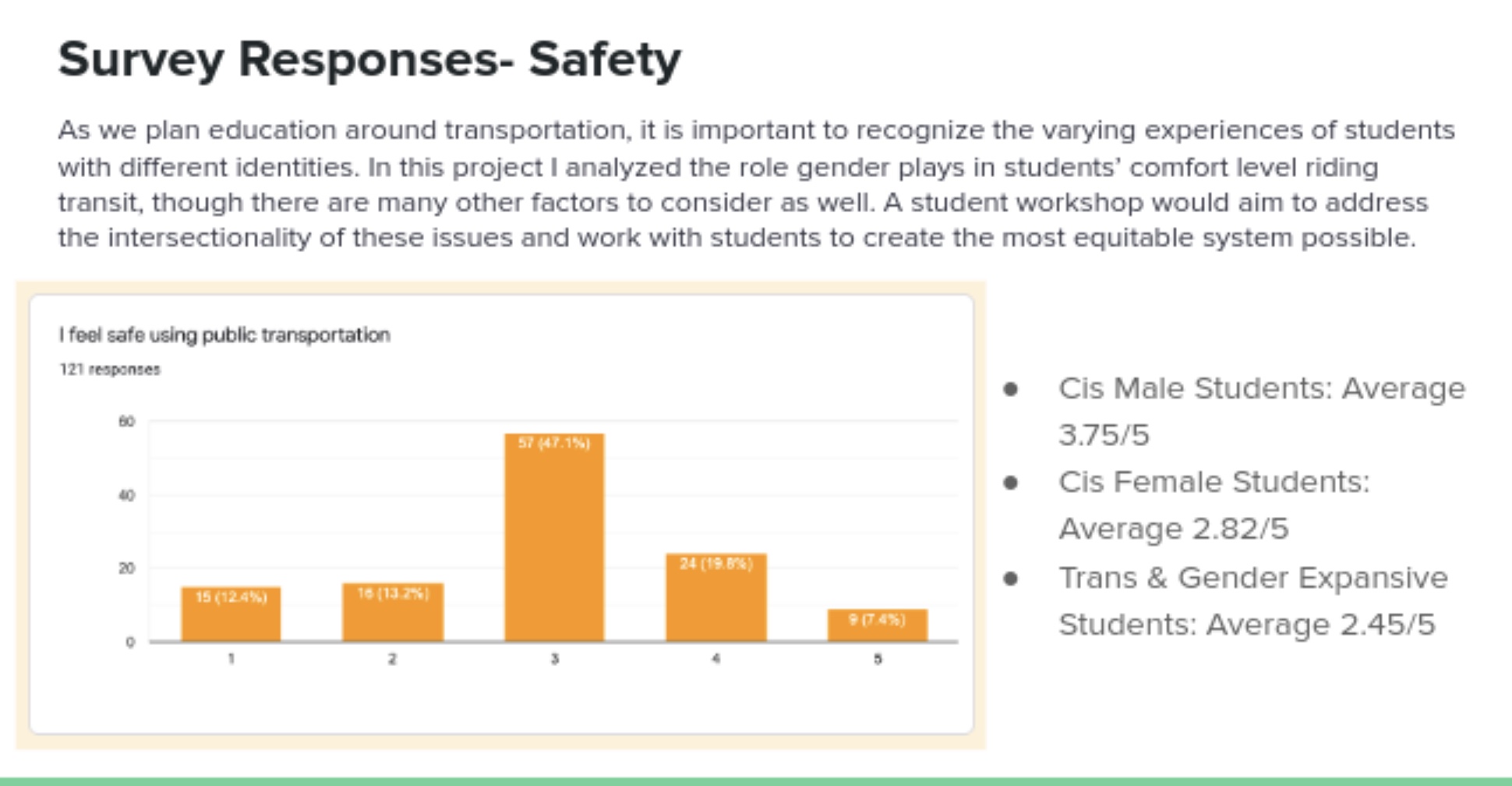
My proposal for transit workshops is inspired by the fond memories I have of participating in Safe Routes to School programming when I was in elementary school. In fourth grade, my classmates and I took part in a multi-week bike safety program where we were taught how to be safe cyclists and encouraged to use biking as a primary mode of transportation.
Students who biked to school on certain days would receive prizes, and the class that did the most walking/biking/rolling to school by the end of May got an ice cream party. Of course, I was most definitely thinking about ice cream and not about emissions reduction, but the impact was still the same.
To me, this program is representative of the start of what valuable transportation education could look like for our students. But it’s only the beginning. I recognize now the inequities within the program — I, a privileged, white student, had access to a bike and lived in a neighborhood with safe crosswalks and sidewalks, while the same was not true for many of my peers. In turn, I was rewarded for walking and biking to school, and students who couldn’t were not.
I now attend Grant High School in northeast Portland, where the majority of the student body is white and affluent. Many of my peers have their own cars, and some have never taken the bus in their lives. This is part of the problem.
At my school, and in our society, taking the bus often comes with negative connotations. Car culture is a symptom of classism and white supremacy that is directly fueling the climate crisis by stigmatizing “alternative” modes of transportation and equating car ownership with social status.
This doesn’t have to be the reality. What if instead of teaching students to associate taking the bus with poverty and inferiority, we started teaching them to view it as a powerful way to interact in community and reduce carbon emissions?
In my mind, I can imagine a world of transportation and climate justice. As a young person, I consider this to be my superpower.
Less worn down by the status quo of what is considered “politically possible,” I see a future where the bus comes every five minutes, where cities are built for people and not for cars, and where each and every one of us has access to the fundamental right of mobility. These things are not radical, they are necessary if we want to maintain a habitable planet.
Achieving this world starts with robust transportation education for our students. I have sent dozens of emails about this project, collected more business cards than I can count, and spent much of the little free time I have on Zoom meetings with various PBOT, Trimet, and ODOT employees. The sentiment is there — most everyone agrees that transit workshops for students are a good idea.
The execution, however, is where it falls short, perhaps because the vast majority of our government’s transportation energy goes to fueling the status quo instead of breaking through it.
So here’s the rub: I’m too busy organizing climate strikes and trying to prevent ODOT from expanding a freeway into my middle school to make this project happen. I am an exhausted, 16-year-old organizer on whose shoulders this work should not fall, which is why I am asking for your help.
Building a better world is going to take all of us, and we each have a different role to play. An organizer I look up to once told me that the climate movement is not a marathon nor a sprint—it’s a relay race, and that every once in a while we must pass on the baton. For this project, I feel I have done my part. Now, I am putting it out into the world in hopes that someone will take the next step to make transit education a reality.
If you’re interested in learning more about this, or even taking the baton, contact me via adahrae32@gmail.com.
— Adah Crandall


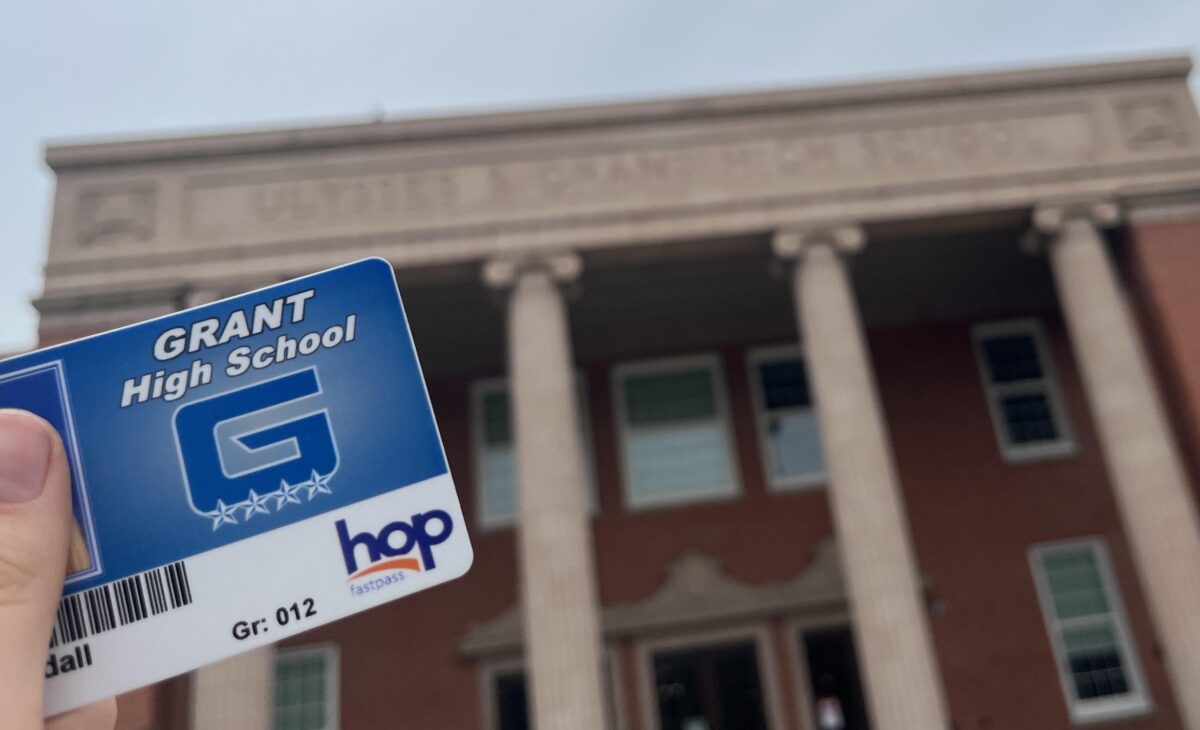
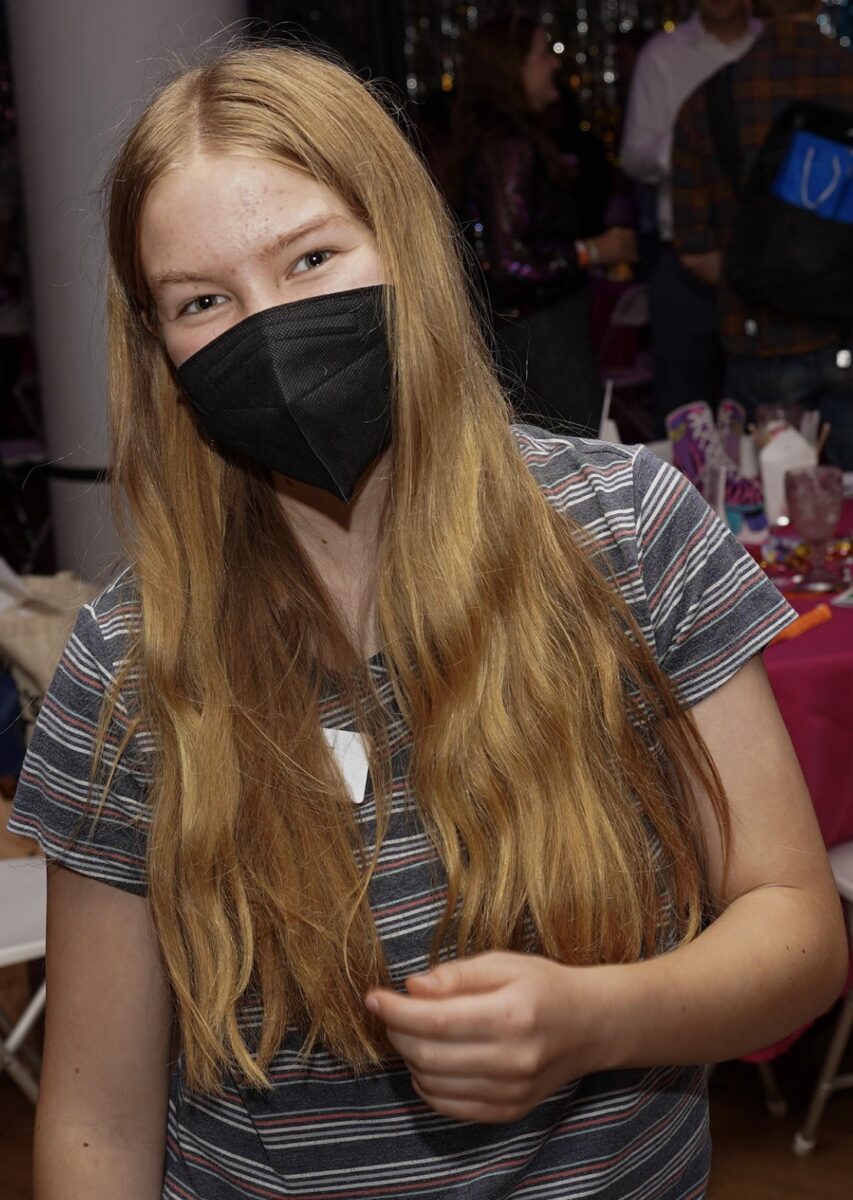
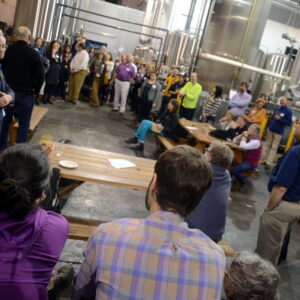

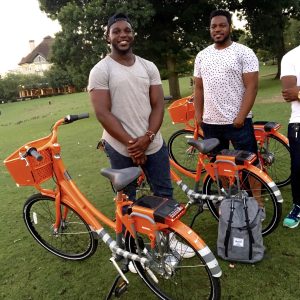
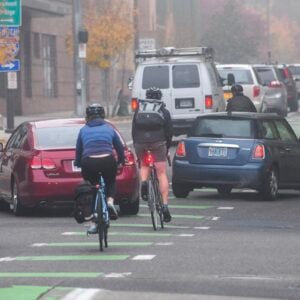
Thanks for reading.
BikePortland has served this community with independent community journalism since 2005. We rely on subscriptions from readers like you to survive. Your financial support is vital in keeping this valuable resource alive and well.
Please subscribe today to strengthen and expand our work.
Well written, and a great idea!
This is a cool idea!
because it’s pretty hard to kill someone by you taking transit
Hello Adah, how exciting to see you writing a piece for BP!
I took the PBOT/PSU transportation class also, many people involved with transportation in Portland have. I don’t think we have a secret handshake or anything, but project discussion is a wonderful icebreaker at receptions. People really bond over having been in that class.
And hats off on your project. But I gotta say, I was surprised by it. Aren’t high school students already big transit riders? They are at Lincoln, or at least they were a decade ago. There’s little free parking downtown, so students got to school by bus and MAX—or on foot, bike too. But I don’t know the numbers …
Here’s an idea, why not put good old peer pressure and competition between high schools to work? Track the mode-share split at each high school for three different groups: teachers, staff and students. And put the pie charts up top on the school web page. (Shame can be a powerful motivator.)
Then compare between schools. I mean, the football teams compete, probably even makes the newspapers sometimes. How about a little friendly competition between schools for a good cause.
Get PPS involved, maybe they can keep track of the mode-split of employees in their building. OHSU is a wonderful model for this, with admirable stats.
Thank you for all your work, Adah.
I would say there’s a big difference between riding the bus to / from your school and using transit to meet your wider transportation needs – that’s where it gets really tricky.
What I remember from my kids riding transit is that they learned which bus took them to and from school, but when it came to riding transit to, say, some event across town, they were pretty lost and overwhelmed and said, Dad! Give me a ride in the car!
Anyway, I think that’s the kind of rider Adah envisions – a truly empowered one. But it won’t solve the problem of frustrated riders who find that it takes two hours to make a Trimet trip (with transfers) that can be made in 20 minutes by car. No education program is going to overcome that problem.
Hey Fred! It’s an interesting problem. I know someone who did a student orientation 4-T trail hike every year for the incoming class. Students (many new to Portland) bonded, got to know some good hiking in the close-in West Hills, and became acquainted with the trolley, tram and train.
Our bus, the 51, has limited, rush hour only, hours (like many in SW). It’s reduced to ferrying Lincoln students back and forth at the beginning and end of the regular school day. If they have extra-curriculars, the bus is no help.
Because of the limited bus, Portland’s whole transportation network is unavailable to us most of the time. I think of that every time I get a fundraising letter from the Portland Art Museum and the Symphony.
TriMet’s Forward Together might help in that it extends the end point of the line south, so that it connects the route to the southern network.
If you want to solve a problem, like getting more HS students to take the bus at your school, the first step is to track it. Track the result you want. Portland culture is very input-focused — plans, outreach, education — not enough focus on whether the goal is getting achieved. Tracking a problem can go a ways toward solving it.
(I saw your comment below about television shows. Boy are you old! 😉 Twitter and Facebook seem like more contemporary time-wasters.)
Thank you for a well-written article, Ada. I agree with many of your perspectives and I appreciate the hard work that I know you’ve been doing. I really like your idea of a Transit Rider Ed course.
I going to share a personal anecdote in case it helps spark some more thoughts on how you can urge your peers to consider using public transit. You likely have similar anecdotes. I’ll frame my short story using the background I included in this 10-year old BP post.
https://bikeportland.org/2012/05/16/new-and-improved-animation-of-portlands-bike-network-and-my-thoughts-71747#comment-2911734
Shortly after I moved to Portland in 1980 and started working on my late-night (graveyard shift) downtown, I had a wonderful “Welcome to Portland” experience on a TriMet bus. One night in December, when I was on the bus heading to work, someone started singing a Christmas carol. In a matter of minutes, others joined in. Soon we were all singing, and I couldn’t (still can’t) carry a tune. It was a flash mob event before flash mobs were a thing, I think. Anyway, it was a positive experience that stayed with me for life, and it definitely shaped how I came to see public transit and those who use public transit.
If your peers who have never ridden public transit had a similar positive experience, perhaps they would come to regard public transit differently. And if your peers are uneasy about riding, perhaps a bus buddy (PBOT Youth Transportation Ambassador?) could accompany them on their first ride.
P.S. It was good to meet you in person when we were working as volunteers at the PBOT tables at the Blumenauer Bridge opening celebration.
Adah, Thank you for all your work on this project, and your thoughtful editorial. I’d like to add some additional thoughts.
I too have taken the Traffic and Transportation class and I’m so glad to read that a high school student joined and contributed to the growing cadre of graduates; that’s one way we can move towards a transportation system that’s safer, more sustainable, and more equitable.
I’m also a former public school teacher, trained Safe Routes to School instructor, and former district Bike and Walk to School Coordinator (Gresham-Barlow).I now work part time as a mechanic at Go By Bike, and part time as a substitute teacher in Portland Public Schools. I’ve worked in nearly every high school and middle school in Portland, and my own children have attended McDaniel (formerly Madison) HS. I’ve seen firsthand the inequity of bike infrastructure in PPS schools and the way it affects the choices students and families have to make regarding school transportation. For example, When I was recently working at Grant, I noticed the wealth of bike parking available to students (I bike to all my sub jobs). I would estimate there were easily 300 bikes parked on campus that day – every bike rack looked full. That same week, on an equally sunny and dry day, I worked at Jefferson HS, where I had to carry my bike up a flight of stairs and lock it to a railing because there are no bike racks at Jefferson. Mine was the only bike I saw on campus that day. It would be easy to surmise that demographics play a part – as you note, Grant’s student body is mostly affluent and white. Jefferson’s is not. My guess is that many of the students at Grant who ride have parents who also ride and help make sure their children are set up. However I’ve also taught at Roosevelt, which shares a similar demographic with Jefferson, and lots of students bike to Roosevelt; the obvious difference with Jefferson is that Roosevelt’s recent remodel included some pretty awesome bike infrastructure, including covered bike parking. That stuff matters; to put it simply, If You Build It, They Will Ride. Anyway, I like your idea of a transit class (for 9th graders maybe?) But what if it was a more comprehensive Transportation class that included Driver’s Ed (Oregon Driver’s Manual), Bike and Pedestrian safety (Maybe with a bike fleet like the Jump Start program used to have?) and transit education.
Grant is not served super well by transit, either, at least not from my neighborhood, at the western edge of the Grant boundary. My kid had to go to Grant a handful of times this summer, and the bus route (with two buses) would have taken 40-50 minutes, and we live about 2 miles away, so that’s actually longer than walking. He ended up biking in part because it was so much faster than the bus. I completely agree with you about demographics of Grant vs Jeff, but Jeff is likely better served by transit, too, and near a few streets that aren’t quite as friendly for bicycling.
I don’t live in NoPo – I live in SW. I sat in a restaurant recently on Killingsworth and was *astounded* by the number of #72 buses that passed – something like one every 5-7 minutes. We who live in SW Portland are lucky to get one bus passing per hour, so I can really see how taking transit in NoPo makes a lot of sense when it’s that frequent and convenient.
Also, a high school class that taught students how to use transit has the potential for some pretty awesome field trips 😉
This is a fantastic idea, Adah, and I appreciate you taking the time to write it up and share it beyond our class — and thanks for the shoutout to my project! I was mad about leaves last fall, but all I’ve done is tweet up a storm. Cheers to you for continuing to be invested in your much-needed project and trying to push it forward.
Also, I’d like to gently point out to other adults that Adah is a talented organizer who is clear that she doesn’t have capacity to move this forward. I don’t think she needs more ideas from us if we aren’t willing to step up and help create something like this. In some of time working with youth organizers, I see a lot of adults like to tell them what to do and how to do it — but not always join in and help.
That’s true, Joan, but we have TV shows to watch. 😉
Thanks for the gentle reminder, Joan. When I responded with my silly story last night, I misunderstood Adah’s current need and failed to consider that she completed her project a year ago. Now I can see why she is so exhausted! In retrospect, I should have read her article more closely and/or contacted her directly. (And Adah, I apologize for misspelling your first name.)
I agree with what Cathy said this morning. It makes no sense to me that at least one of the agencies Cathy listed hasn’t created a pilot yet based on Adah’s project work. If one of the agencies does eventually create the curriculum, I could envision a possible role for PBOT Transportation Ambassadors (adults and youth) to help out. In that case, I’d certainly be willing to help. My Ambassador badge is now many years old, however, so I’d need to re-up. I’ve never taken the PBOT/PSU Traffic and Transportation course, which also looks intriguing.
I strongly support the actions of feral young anarchists.
The feral young anarchists are truly our best hope.
Nice work, Adah! You’ve hit on something really important here, which is that transit is REALLY hard to use, for most people. I’ve heard people (mostly old people like me) say things like, “They recommended I take the bus but I have no idea how – where to get on and off, how to pay, etc.” So clearly there’s a big skills gap that needs to be filled.
I’m continually inspired by young people these days. 30 years ago when I was 16 I wasn’t doing anything nearly as great as Adah is doing. Thanks, Adah!
I was in the PBOT/PSU Traffic and Transportation with Adah Crandall last fall. I said it then and say it now, hers was the best project idea presented. Adah had done a solid background needs assessment, lesson plans, and a plan of action. She’d even done comprehensive surveys of her peers. That’s how she got this excellent data:
That’s why I’m astounded PBOT, BPS, ODOT, Portland Public Schools, TriMet, Metro or some other agency hasn’t picked up Adah’s idea to pilot and push forward by now.
I’m sorry. Everything can’t be a volunteer advocacy effort. We have whole agencies filled with people tasked with climate action, trip reduction, environmental justice, road safety. Wake up please. Get creative. Our kids are counting on you.
I agree Cathy. Can’t someone at PPS initiate a mode-split analysis? Maybe it’s already being done. Schools — the students and employees — represent a lot of people on the road.
Driving to school is an enormous equity issue too. Car insurance for people under 25 costs $1000s more than for older drivers. And in 2022 the AAA pegs the cost of owning and maintaining a car at $10,728.
The cost of getting around by car is an unsustainable luxury for most kids and their families. That’s one of the many reasons in 2018 just 25% of 16-year-olds had driving licenses, down from 46% in 1983. So many of our agencies and institutions are still in the groove of supporting a car-based world that no longer works for most of us.
I agree that Adah’s project is excellent and it would be great to see it implemented in a systematic way. I also want to point out that Trimet, PBOT, PPS, and all these agencies are strapped like every place right now — the world is short staffed, etc. We ask a lot of our public agencies, and it would be great if they were doing more, but also let’s remember there are real humans behind these agency names. Everyone is stretched and frazzled. And something that involves multiple agencies, and school curriculum — that’s a huge project. A good project, but something that would likely take a lot of interagency work even in fully-staffed times. Adding something to the school curriculum is a lot, too. That’s not a criticism of Adah’s project, to be clear.
TriMet, like all FTA-approved transit agencies, has money set aside to do exactly what you envision – they call it “rider training.” Although it’s mostly done to train ADA paratransit riders, the funding can be used to train any rider. They’ve been doing it at least since 1992, but apparently not hitting a high school target audience.
(This is slightly off-topic, but does PPS offer driver’s ed? My kid’s school does not, and and I’ve learned that driving lessons are incredibly expensive. Is this one of those things where richer high schools still have this on the books?)
My kid has to take two buses plus walk to get from our home near Laurelhurst theater to Cleveland high school. I wish there were a north south option along 20th. For now…so. Much. Driving. She doesn’t feel safe biking. We have lots of camps and weirdos along the route in inner NE and SEplus some tough crossings to do after dark.
In my neighborhood, Portsmouth, I’m not sure I would even let my daughter ride the bus except to school. I’d rather her drive to work, etc. and I know I am not the only parent who feels that way.
I just came across this post that I see is a couple years old. Chiming in to say I also took that Portland Transportation class (I used to live in PDX) and now I live in MA and I run a “Transit Explorers” program for youth in 6th-12th grade to do exactly what is suggested here. I run it on half days. It is a 3 hour program. I introduce them to how to map out their trips via Google transit, how to use transit tracking apps, we discuss how to pay fares, any student rates, etc. We then take a trip on transit, stop for a treat (usually ice cream), and we leave time for Q&A and give them time to consider where they want to travel and test out how we might get there. Like someone else mentioned, most of the usual travel training funds are for seniors and people with disabilities, not the general public or youth.
Thanks for writing in, Susan!
If you work in the Boston metro area, you probably need to spend 2 of those 3 hours on how TF to use a Charlie Card, which, for readers who don’t know, is one of the most complicated, arbitrary, and baffling pieces of transit technology every developed.